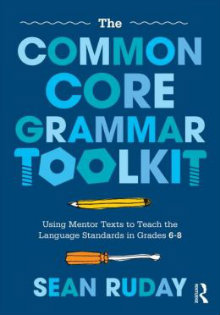Grammar Toolkit Offers Ease of Use, Depth
The Common Core Grammar Toolkit: Using Mentor Texts to Teach the Language Standards in Grades 6-8
By Sean Ruday
(Routledge, 2014 – Learn more)

Every ELA teacher knows that grammar instruction based on worksheets and diagrams doesn’t produced more understanding in students or better writing in our classrooms. Yet many of us persist in using such approaches. Sean Ruday shows us how to break free.
In The Common Core Grammar Toolkit, Ruday uses mentor texts as the basis of step by step mini-lessons for several of the language standards for grades 6-8 (there’s also an edition for grades 3-5). While using mentor texts is nothing new, Ruday provides specific examples of texts and grammar concepts that can be illustrated using them, making this easier to put them to work right from the get-go in our classrooms.
Ruday also uses the “gradual release of responsibility” model for his mini-lesson progression. This could easily be integrated into a reading and writing workshop approach or introduced as a new strategy if you aren’t already using workshop in the classroom.
 A user-friendly approach
A user-friendly approach
The book itself is easy to follow and use, with each grade level having its own section. Within those sections, each standard is listed and its importance in writing explained. Ruday provides mentor text examples, followed by a classroom snapshot of his experience teaching the grammatical concept. Sections end with specific instructions for gradually giving students control of the concept.
Each grammatical concept has the same basic steps:
- Introducing the fundamentals of the concept.
- Showing students examples in mentor texts.
- Having students play with and manipulate examples from texts and discussing importance of the concept.
- Students finding their own examples with groups from other grade level texts and explaining them.
- Students focusing on implementing the concept into their own writing.
- Reflecting on the importance of the concept.
Ruday does a great job creating a clear picture of exactly what this would look like in a classroom, which is invaluable to teachers in trying to recreate it. While the concepts of using mini-lessons and mentor texts to teach specific grammatical concepts is an established method of grammar instruction, the practical process he uses does seem to be one that any ELA teacher could easily follow and stick to — something I’ve found lacking in other methodologies I’ve tried.
Familiar and fresh mentor texts
One of the real advantages of The Common Core Grammar Toolkit is its specific examples from texts that you may already be using in your classes or that have high interest among middle schoolers. There is also the option to download an annotated bibliography with additional mentor texts and suggestions for their use in regards to standards and concepts illustrated.
An appendix includes a variety of graphic organizers (also available online for download) to use with students, as well as tables within the book that could be replicated in the classroom as anchor charts for teaching the fundamentals. One feature I really appreciated was the inclusion of a section on how to assess student learning both formatively and summatively, with options for both. All of these additions make this a book I appreciate having in my toolkit.
For new teachers and vets
The concepts here aren’t new but they are well explained and easy to follow, allowing for immediate classroom use. For someone just entering the teaching field, the straightforward and explicit explanation of each concept and how to convey it to students would be a real asset.
After switching up my grammar instruction for years with little improvement, I recently told a colleague, “I am DONE teaching grammar!” But of course I can’t be. I have high hopes that using Ruday’s lessons and format with my seventh and eighth grade classes this school year will change my outlook.
That being said, all the Common Core language standards aren’t covered in this book (approximately 3 standards per grade are included) so if you were looking for a one-stop shop for “hitting” all the standards, this isn’t the place. That said, the focus is on the harder to attain standards for each grade, and in my opinion one could easily adapt the format of the sequenced mini-lessons to the rest of the standards.
A minor point, but one that bothered me, is why the author chose to explain his rationale for mini-lesson sequencing at the end of the book rather than the beginning. I recommend reading that first.
If you are looking for some specific grammatical mini-lessons to include in your instruction or trying to rid yourself of traditional worksheets for good, The Common Core Grammar Toolkit would be a resource to consider.
Rebecca Crockett currently teaches middle school language arts and reading in north central Idaho. She is in her eighth year of teaching. She is also part of the Idaho Core Teacher Leader Program involved in developing and reviewing units, lessons, and assessments that align with the Common Core State Standards and providing professional development in instructional practices and CCSS implementation.






































I really like this book! I read it earlier this summer was really impressed. I can’t wait to use the ideas in it in my classroom this year!